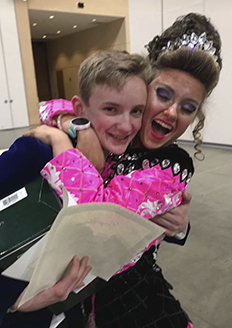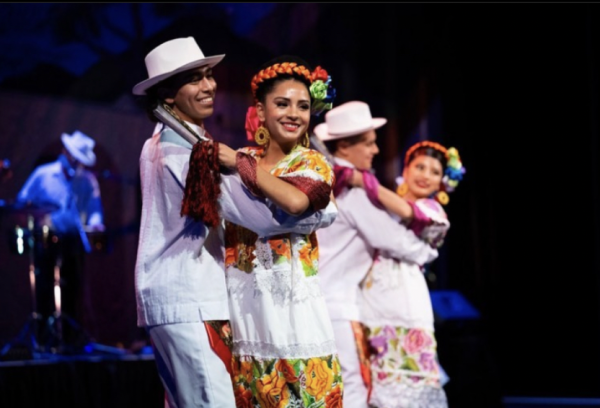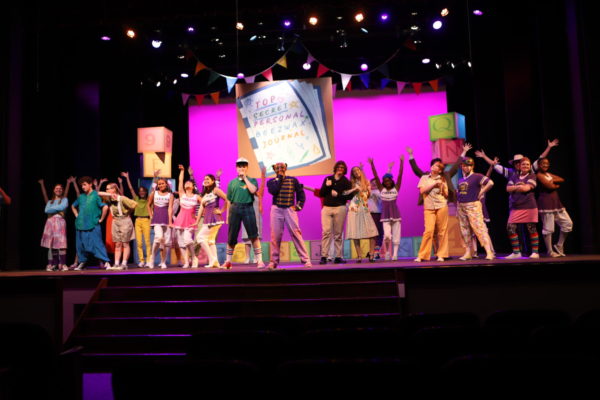Dancers to represent school heritage at Worlds
Irish dancers will travel to Scotland

Freshman Hayes Teasley and sophomore Megan Kaster pose after their Regional competition.
Every year during the week before Easter, Irish dancers from around the world gather for the World Irish Dance Championships. Sophomore Megan Kaster and freshman Hays Teasley have both qualified for this year’s event.
When Kaster and Teasley found out that they qualified, they were both filled with emotion.
Kaster said, “I was freaking out and I was so excited and I was crying.”
Teasley said, “I was really happy. I saw all my friends side stage being really happy and it just felt really good.”
The reason behind these emotional reactions is the amount of work it takes to achieve this difficult goal, Kaster said.
Both Teasley and Kaster spend large amounts of time working to improve their dancing.
“I have studio practice five days a week, and those practices last one to three hours each,” Teasley said.
“I practice every day for two hours or more,” Kaster said. “Finding time to fit everything in is the hardest part.”
How to qualify
Irish dancers can either qualify for the World Championships at the Oireachtas, the Regional competition, or the North American Irish Dance Competition, the National event. Therefore, in order to qualify for Worlds, an Irish dancer must first qualify for either the Oireachtas or the national competition.
Qualification for the Oireachtas varies based on the age of the dancer. “All age groups under u14 have to get first, second or third in Prizewinner. Age groups u14 and older have to be in the preliminary championship level, or PC, and they have to place in the top 50 percent,” Teasley said.
According to Teasley, the PC level is one step above the Prizewinner level. In order to move up to PC, a dancer must win all of his or her dances in Prizewinner.
At the Oireachtas, a dancer must place in the top 16 percent of his or her competition to qualify for Worlds.
The other way to qualify for Worlds involves the National competition. A dancer qualifies for Nationals by rising to the level of Open Championship, the highest level in competition. The top 35 percent of each competition at the Oireachtas also qualifies for Nationals.
“At Nationals, the top 25 percent qualify for Worlds,” Kaster said.
How they did
Kaster qualified for the World Championships at Nationals, but she also placed high enough at the Oireachtas to earn a spot. “I was happy that I was in the qualifying spot at Oireachtas, because I think I would have been upset if I wasn’t,” she said.
Kaster’s qualification was surprising to her, she said. “At Nationals I wasn’t expecting it because in 2016 I was 44th and this past year I was 13th,” Kaster said.
Teasley also said he did not think he was guarenteed a qualifying spot. “I was really hoping to,” he said. “I felt that I had a really good chance this year because last year I was one place away from qualifying, but I wouldn’t say I was excepting it.”
Kaster placed 16th out of 102 at the Oireachtas. Teasley placed sixth out of 20.
This year will be Teasley’s first World Championships. He said, “I don’t really expect anything because this will be my first Worlds. Just a recall would be nice.”
A recall occurs when a dancer places in the top half of his competition.
It is Kaster’s second World Championships; she danced at the 2016 World Championships in Glasgow, Scotland. The 2018 World Championships will also take place in Glasgow.
To prepare for Worlds, Kaster and Teasley will keep their same routines, although they will add more practice time. “Every weekend there’s a workshop in Ohio,” Kaster said.
Although there is a lot preparation to come, Teasley said he feels confident about the upcoming World Championships.
He said, “I feel that I’ve come really far in my dance career. It’s taken a lot of self discipline to accomplish my goals. If you want something you have to work for it.”






